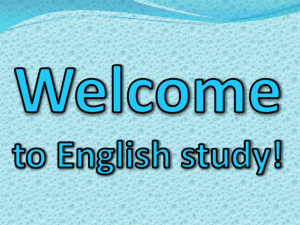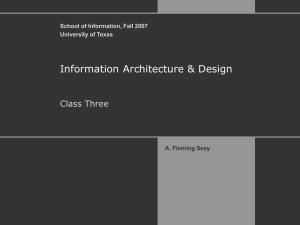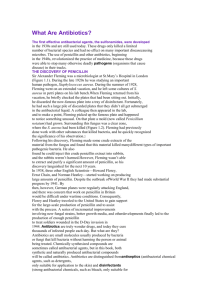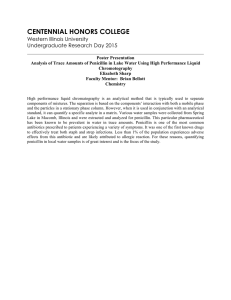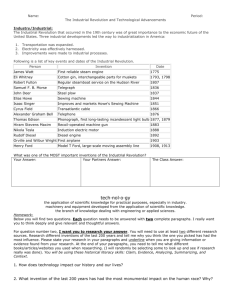Chance and Irish Involvement in Two Scientific Revolutions William Kingston Molecular biology
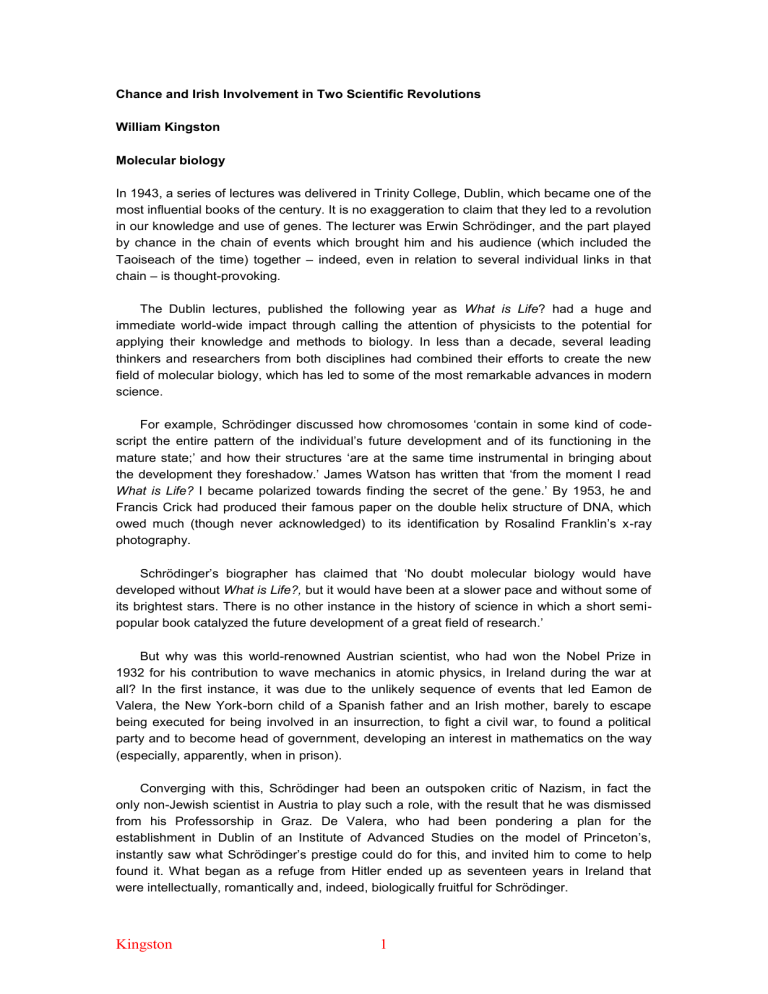
Chance and Irish Involvement in Two Scientific Revolutions
William Kingston
Molecular biology
In 1943, a series of lectures was delivered in Trinity College, Dublin, which became one of the most influential books of the century. It is no exaggeration to claim that they led to a revolution in our knowledge and use of genes. The lecturer was Erwin Schrödinger, and the part played by chance in the chain of events which brought him and his audience (which included the
Taoiseach of the time) together – indeed, even in relation to several individual links in that chain – is thought-provoking.
The Dublin lectures, published the following year as What is Life ? had a huge and immediate world-wide impact through calling the attention of physicists to the potential for applying their knowledge and methods to biology. In less than a decade, several leading thinkers and researchers from both disciplines had combined their efforts to create the new field of molecular biology, which has led to some of the most remarkable advances in modern science.
For example, Schrödinger discussed how chromosomes ‘contain in some kind of codescript the entire pattern of the individual’s future development and of its functioning in the mature state;’ and how their structures ‘are at the same time instrumental in bringing about the development they foreshadow.’ James Watson has written that ‘from the moment I read
What is Life?
I became polarized towards finding the secret of the gene.’ By 1953, he and
Francis Crick had produced their famous paper on the double helix structure of DNA, which owed much (though never acknowledged) to its identification by Rosalind Franklin’s x-ray photography.
Schrödinger’s biographer has claimed that ‘No doubt molecular biology would have developed without What is Life?, but it would have been at a slower pace and without some of its brightest stars. There is no other instance in the history of science in which a short semipopular book catalyzed the future development of a great field of research.’
But why was this world-renowned Austrian scientist, who had won the Nobel Prize in
1932 for his contribution to wave mechanics in atomic physics, in Ireland during the war at all? In the first instance, it was due to the unlikely sequence of events that led Eamon de
Valera, the New York-born child of a Spanish father and an Irish mother, barely to escape being executed for being involved in an insurrection, to fight a civil war, to found a political party and to become head of government, developing an interest in mathematics on the way
(especially, apparently, when in prison).
Converging with this, Schrödinger had been an outspoken critic of Nazism, in fact the only non-Jewish scientist in Austria to play such a role, with the result that he was dismissed from his Professorship in Graz. De Valera, who had been pondering a plan for the establishment in Dublin of an Institute of Advanced Studies on the model of Princeton’s, instantly saw what Schrödinger’s prestige could do for this, and invited him to come to help found it. What began as a refuge from Hitler ended up as seventeen years in Ireland that were intellectually, romantically and, indeed, biologically fruitful for Schrödinger.
Kingston 1
Chance also played a final dramatic card in relation to these lectures. They were to be published by a Dublin firm, Cahill’s, but for the book Schrödinger wanted to add an epilogue on ‘Determinism and Free Will,’ dealing with their philosophical implications. He was almost as much a philosopher as he was a scientist, and it is plausible that his ability to be heard by biologists as well as physicists, which had such remarkable consequences, owed much to this.
He had always been attracted to Indian mysticism, with its concept of the identity of the personal self with an allcomprehending universal self, and in this epilogue he accused ‘all official western creeds’ of ‘gross superstition’ for their belief in individual souls. He seemed to be unable to grasp that he was living in a country where this belief was strong and where these words could stimulate powerful forces against his Institute. Even the fact that the last line of the final lecture had been that ‘the chromosome is the finest masterpiece ever achieved along the lines of the Lord’s quantum mechanics’ could not mitigate the offence this epilogue would cause.
At this distance, we cannot know the full story, but what is certain is that Cahill’s could not publish the book in the form Schrödinger wanted. It is safe to assume that he came under pressure to abandon the epilogue, likely through his friend, Monsignor Browne, professor of mathematics at Maynooth. Browne was a polymath, who was widely taken to be living evidence that there was no conflict between science and ‘official creeds.’ It did not help that he was th anked by Schrödinger in the preface for helping him with his English in the work, which could have associated Browne with unorthodox views.
This pressure failed, to the world’s great advantage, as Schrödinger stood firm, and the book was published by Cambridge University Press. The fortunate result was that the lectures immediately came to the notice of all the world’s scientists, whereas if Cahill’s had published them, Schrödinger’s ideas would have had only local and limited circulation, probably with correspondingly little influence.
Antibiotics
The second scientific revolution in which Ireland had a chance involvement was that of antibiotics. This has been described as the ‘ domestication of microorganisms,’ and it ranks in importance with the domestication of animals as part of settled agriculture about 10,000 years ago. It depends upon antagonism between bacteria, which had been noticed as early as
1874, and Pasteur commented then that if we could learn how to intervene in this antagonism, it would offer ‘perhaps the greatest hopes for therapeutics’.
Although bacterial antagonism was ‘in the air’ from that time, medical interest in it was distracted by successive waves of discovery in antiseptics, vaccines and chemotherapy. What then began the antibiotic revolution was an experiment that went wrong for Alexander
Fleming of St. Mary’s Hospital, Paddington, London, in 1928. After being away on holiday, he noticed that the growth of bacteria that he had left to culture had been stopped by accidental contamination by a mould. This turned out to be penicillin, which he investigated as best he could, but found it to be highly unstable. Consequently, after publishing a paper in 1929 in which he called attention to its possible therapeutic potential, he abandoned work on it.
Kingston 2
Next, in 1935, an Australian, Howard Florey, became Professor of Pathology in Oxford.
With backing from the Rockefeller Foundation, he was able to recruit Ernst Chain to introduce the new discipline of biochemistry to the University. (Chain had been a Professor in Berlin, but had to flee from Nazi persecution of Jews). They agreed that his research would begin with an earlier discovery of Fleming’s, lysosyme . Florey obtained a grant of £250 from the
Rockefeller Foundation for this, and as Foundation officials later observed, ‘seldom has so small a contribution led to results so momentous.’
In searching the scientific literature with Fleming’s name in mind, it was inevitable that
Chain would come across his 1929 paper and be interested in it, especially as there was a sample of the mould in Oxford. He began work to isolate and purify this ‘not because I hoped to discover a miraculous drug for the treatment of infection which, for some reason, had been overlooked, but because I thought i t had real scientific interest.’ With better resources than had been available to Fleming, by 1940 the extraordinary power of penicillin to deal with a wide range of bacterial infections was proved beyond question and published to the world in an article in The Lancet by Chain and Florey . Some progress was also made towards getting the substance under control. In this work, the contribution of Norman Heatley, who was amazingly resourceful in designing and building the equipment needed at a time of wartime shortages, was crucial. It was he who developed the system of dosage measurement for penicillin that became and remains the worldwide standard.
Even though it was clear that the casualties anticipated from World War II would need penicillin in great quantities, the needed resources for its production were just not available in
Britain. Florey therefore obtained permission from the authorities to seek help in the United
States, where he succeeded beyond anything that could have been hoped for, so that there was enough penicillin to treat all the allied wounded in the D-day landings and afterwards.
This was later said by the Americans ‘to have saved as many lives, and mitigated as much suffering, as the war cost us.’
Unfortunately, one disease on which penicillin had little effect was tuberculosis.
Nevertheless, it was directly due to its innovation that the second founding drug of the antibiotic revolution, streptomycin, which could treat it, was discovered. The process whereby this came about could not have been more different from that of penicillin, and the key individual, Selman Waksman, was not even in the medical field. He was a soil microbiologist in Rutgers University, New Jersey, and since his arrival in the United States from Russia as a student, he had specialised in the study of actinomycetes, which are bacteria that live in the soil.
When Waksman learned of the success of Florey and Chain with penicillin in England, he is reported to have rushed into his laboratory and shouted to his colleagu es: ‘Drop everything!
See what these Englishmen have discovered a mould can do. I know the actinomycetes will do better!’ Merck, one of the great pharmaceutical firms, had already been funding
Waksman’s research, and they were also involved in the American production effort for penicillin. As well as this, they also knew about remarkable clinical successes with this drug that Drs. Dawson and Hobby were having in New York (and which eventually led these two to another big advance, which was the ability to administer penicillin orally).
Merck consequently funded investigation of Waksman’s collection of actinomycetes for antibacterial qualities. Within a few months, streptomycin had been discovered, and it was
Kingston 3
announced in a 1944 paper. Not long afterwards, researchers from the Mayo Institute found that it was amazingly powerful against tuberculosis. In the 9 years from 1950, for example, the death rate of children from this disease in Western countries was reduced by no less than
90%.
Irish elements
The first Irish person to become involved in this story was John Tyndall. He was born in Co.
Carlow, began as a draughtsman on the Ordnance Survey, was able to get to the University of Marburg to learn chemistry from Bunsen, and ended up as a distinguished Fellow of the
Royal Institution in London. In those days, research did not demand the huge investment in resources and instrumentation that it does now, and he was able to make many important contributions to science. Tyndall was aware of bacterial antagonism very early on, and in
1876 he wrote to Thomas Huxley that ‘the most extraordinary cases of fighting and conquering between the bacteria and the penicillium have been revealed to me.’
Alexander Fleming had found himself in St. Mary’s and able to do research in what was a comparatively well-equipped laboratory for the Britain of the time, because he had been recruited by Sir Almroth Wright to look after vaccine production there. Wright was a TCD graduate, and a friend of George Bernard Shaw, who used him as the model for the character of Sir Colenso Ridgeon in his play The Doctor’s Dilemma. The repeated injunction of Ridgeon in the play to ‘stimulate the phagocytes’ mirrors Wright’s near-obsession with vaccines as the ne plus ultra of therapeutic medicine. He w as convinced that ‘the physician of the future will be the immunisator.’
Fleming’s wife was Sarah McElroy from Killala, Co. Mayo, who had trained as a nurse in the Adelaide hospital in Dublin. She was very proud of being Irish, changed ‘Sarah’ to
‘Sareen,’ and always insisted on being called by this name. There is a memorial to her (as
Lady Fleming, since Alexander was knighted for discovering penicillin) near Leenane.
But by far the most important of the Irish connections are in the answers to the questions, why was Fleming doing this particular experiment, and why did it go wrong for him?
In 1926, the Medical Research Council decided to publish a 9-volume compendium, called ‘A System of Bacteriology,’ which was intended to include everything known at the time about the subject. Fleming was commissioned to write the chapter on staphylococci, bacteria commonly associated with infected wounds, boils and the like. As a result, he was alert to scientific papers with this word in their title. In 1927, a pap er on ‘Variant Colonies of
Staphylococcus Aureus’ by John W. Bigger, C. W. Boland and R. A. Q. O’Meara of TCD, appeared in the Journal of Pathology. Because of his commission from the MRC this of course interested Fleming. His interest may have been all the greater because he had a curious hobby of painting with different coloured bacteria, and the Bigger paper related the virulence of staphylococci to their colours. In any event, as a good scientist, Fleming replicated the experiment to confirm the authors ’ findings, and it was this experiment that went wrong for him.
But how did it go wrong? Charles la Touche from Greystones, Co.Wicklow, a member of the old Irish banking family, was a mycologist, a specialist in fungi. In the 1920s there was a theory that asthma was caused by proximity to cobwebs, and la Touche was researching this in St. Mary’s. Here, he had filled a laboratory with a large collection of cobwebs from every
Kingston 4
part of London. It was first thought that the mould that contaminated Fleming’s experiment had come into his laboratory through an open window, but later research showed that the only possible source of the penicillin was la Touche’s collection, and that it must have come up though a lift shaft. La Touche identified the contaminant on F leming’s experiment correctly as penicillin, but it was only later, and in the United States, that the exact variant was pinned down. He later came to University College Dublin, where he was remembered affectionately by doctors who learned their pre-Med. Botany from him. Interestingly, in the days before scientific medicine, a common treatment for an infected wound was to place a cobweb on it, and it is plausible that those who did this were treating the wound with penicillin without knowing it.
The cruc ial element in the Bigger, Boland and O’Meara paper was an instruction to culture the bacteria at room temperature instead of incubating them. The importance of this for Fleming’s experiment is that penicillin does not kill bacteria, but acts on their cell walls as they are dividing, and so prevents their growth. This was why Fleming and his small team found it so difficult to handle, and in fact they were never able to repeat the original experiment, because they kept trying to use penicillin against fully-grown bacteria. Only as late as 1966 could Fleming’s assistant, Ronald Hare, reconstruct what happened. If the staphylococci in Fleming’s experiment had been cultured by incubation instead of at room temperature, they would have grown so rapidly that la T ouche’s penicillin mould would have been overwhelmed by them.
One of the historians of penicillin has written that ‘Without Fleming, no Chain or Florey; without Chain, no Florey; without Florey, no Heatley; without Heatley, no penicillin’ But surely to t his should be added, ‘Without Bigger and la Touche, no Fleming?’ Yet, there is every reason to believe that Bigger never knew of the crucial part his and his colleagues’ work had played in the development. Nor did la Touche know that he, too, had unwittingly helped to start the antibiotic revolution. The detailed information about Fleming’s experiment and its failure was only published by Hare in 1970, and by that time Bigger was dead.
He and Fleming did know one another and Fleming of course had cited the Bigger paper in his article on staphylococci in the MRC ‘A System of Bacteriology.’ There was no reason, however, why Bigger should ever have thought that Fleming had tried to replicate his experiment, much less that he would have imagined the extraordinary consequences of
Fleming having followed his methods about culturing the bacteria when the penicillin contamination occurred. Given the astounding importance of penicillin afterwards, it is impossible to believe that if either Bigger or la Touche had made the mental connection, they would not have mentioned it to their colleagues, but there is no trace at all of this in Irish medical folklore.
A remarkable irony about Bigger’s contribution to penicillin is that, when war came, he joined the Royal Army Medical Corps (RAMC) and in this capacity, he carried out research on the persistence of bacterial resistance to the drug, that is still important enough to be cited.
Tiny amounts of penicillin began to come into Ireland around the end of the War, and doctors who were then on the wards have vivid memories of apparently ‘miraculous’ cures of patients. (The only European country where significant quantities of the drug were available earlier to the civilian population was France, where a facility was set up in Paris to extract penicillin from the urine of American soldiers in hospital).
Kingston 5
But of course it was streptomycin, when it came a few years later, which made the most impact in Ireland. Dr. Noel Browne, who had suffered from tuberculosis himself, and three of whose family had died from it, was Minister of Health in the 1948 Coalition government, and was determined to do something to rid the country of this disease. He was able to persuade the Cabinet to provide the funds to build sanatoria all over the country, which became available at around the same time as streptomycin. However, it was the drug, not the hospitals, that effectively put an end to a disease which had been the scourge of the country for generations past.
Chance
Did the antibiotic revolution have to happen in the way just described? Indeed, did it have to happen at all?
To begin with, Fleming was in St. Mary’s because Almroth Wright recruited him, but why was Wright there? As head of the Army’s hospital at Netley, he had developed a vaccine against typhoid fever, which was especially badly needed by soldiers on foreign service, and which eventually saved countless of their lives. But it was initially rejected by the Army authorities, so Wright resigned his Commission in the RAMC and went to St. Mary’s, where he set up his little vaccine ‘factory’ which was run by Fleming.
Perhaps the best known of Pasteur’s obiter is that ‘in matters of observation, fortune favours only the prepared mind.’ When Fleming noticed ‘something odd’ about his experiment on returning to it after his holiday, he did not just discard it as a culture that had been made useless through having been contaminated. His mind was prepared, because he had earlier discovered lysosyme in mucus in his nose when he had a cold. He had hopes that this would have antibacterial quality, but was disappointed in its weakness. Nevertheless, without his experience of it, he might not have adverted to penicillin, and it was also because Florey and
Chain set out to study lysosyme that Chain was led to Fleming’s 1929 paper. How low must be the chances of such a sequence of events?
Even more improbable must be the coincidence in time of Fleming’s commission from the
Medical Research Council for a chapter on staphylococci and the appearance of the Bigger,
Boland and O’Meara paper with a similar topic in its title. Then add to the odds against this, the presence of la Touche in the same building with a physical connection between his and
Fleming’s laboratories. And that within la Touche’s collection of cobwebs the one which escaped and contaminated Fleming’s experiment was unique: ‘Fleming’s strain had the ability to produce penicillin at a level that put it in a class of its own, and it was one so rare that it would have been most unlik ely to be rediscovered.’ To all of these unlikely elements in what happened must also be added that Fleming’s holiday period was exceptionally cold for the time of year. Had it not been, even though the bacteria in his experiment were not being incubated, they might still have grown too fast for the accidental penicillin contamination from la Touche’s cobweb collection to cope with them.
And what about the chances of the right individual coming at the right time, in the right place? Nothing great was ever done, it has been said, unless someone dreamed that it might be; someone believed that it could be; and someone decided that it must be. In the penicillin case, the person who did all three of these was Florey. Fleming’s is the name that everyone knows, but this is because he was always ready to give interviews, whereas Florey disliked
Kingston 6
having anything to do with the media. But he was the real hero of the story. He wore himself out travelling all over the United States trying to get the major drug firms to take up the production of penicillin - ‘made to feel like a carpet-bag salesman trying to promote a crazy idea for some ulterior motive.’ When enough of the drug had become available for the campaign in North Africa, the army doctors refused to use it, so Florey himself went to the battlefields to persuade them.
This was by no means the only time that the antibiotics record confirms that ‘the hardest substance in the world must be that of the human skull, when you think of what it takes to get a new idea through it.’ Roger Reid, a student in Penn. State University, obtained a sample of the penicillin mould from Fleming and wrote two papers on it as early as 1934-35.
Nevertheless, his Professor dissuaded him from doing his doctorate on it. Even more striking, when Brotzu, the Medical Officer of Health of Cagliari in Sicily, found bacterial antagonism in local sewage and isolated the cause, he could raise no interest from scientific journals or drug firms. In desperation, he published a journal himself with an impressive-sounding title, Lavori dell’ Istituto d’Igieni di Cagliari . This only ever had a single issue, which contained only a single article, his own. He then sent an ‘offprint’ of this with a sample to Florey in Oxford.
Florey took this seriously and the result was the Cephalosporins, a new generation of antibiotics.
Would it have happened anyway?
Hindsight has such power over us that we find it almost impossible to grasp that nothing that we know about needs to have happened at all. The author of F leming’s entry in the Dictionary of National Biography observes that ‘of course, penicillin would have been discovered by the later work of Chain and Florey.’ This is extremely doubtful. Florey put Chain to work to bring his new expertise in biochemistry t o bear on Fleming’s earlier discovery of lysosyme, from which everything subsequently flowed. If there had been no lysosyme, Chain’s attention would presumably have been directed to something altogether different, in which case he would not have come acros s Fleming’s 1929 penicillin paper.
Chain himself thought that penicillin would have been discovered after Waksman had found streptomycin, by the use of Waksman’s technique of ‘long-term and systematic’ screening. Again, this is questionable, since Merck’s backing of Waksman’s search of his collection of actinomycetes only came about because of the success of penicillin. There is another interesting aspect to systematic screening in the antibiotics context. The Germans of course learned about penicillin from the Chain-Florey 1940 paper, and indeed were able to send information about it to their Japanese ally by submarine, but they never had it available in quantity to treat their forces’ injuries, as the Allies had.
The reason was that it was they who had invented the screening techniques to which
Chain referred, and these were linked to developing synthetic versions of natural drugs, which had provided them with their greatest successes. Naturally, they tried to synthesise penicillin also. It defeated them, just as it defeated the thousands of scientists the Americans matched against it, second only in numbers to those in the Manhattan Project for the atomic bomb. In the end, this goal was reached by a lone scientist, Sheehan, after the war. It was only because the Americans had maintained a parallel programme of large-scale production of natural penicillin, that there were supplies of it to save the lives and limbs of so many Allied troops.
Kingston 7
There are other causes for doubt that ‘it would have happened anyway.’ In subsequent writings, Waksman was extraordinarily honest about several times in his research when he had bacteriological antagonism on the laboratory bench in front of him, but failed to recognise it. One such case was in 1923, five years earlier than Fleming. There can be no doubt that
Professor Gratia of Liege also anticipated Fleming, although he did nothing at all with his experiment. And then, tellingly, there was izoniazid (INH), which was so powerful that it could even substitute for streptomycin against tuberculosis. This had been synthesized as long ago as 1912, but its effectiveness was not demonstrated until the firms of Bayer, Hoffmann-la-
Roche and Squibb all did this independently in 1951. Without the previous penicillinstreptomycin history and stimulus, would its importance and value ever have been recognised?
To the professionals who calculate chances, the probability of independent events occurring simultaneously is the product of their individual probabilities. Thus, if each of two separate events has a chance of happening of 1 in 4, the chance of their both happening together is 1 in 16. When the odds against each of the components discussed above are put together in this way, their product quickly goes beyond even the most vivid imagination’s ability to capture. We are, quite literally, incredibly lucky to be the beneficiaries of the antibiotic revolution.
The stories of both the molecular biology and antibiotic revolutions tell of genius and remarkable effort, but above all they stress how both are at the mercy of chance, which seems to be linked in some curious way to the creativity that is at their heart.
William Kingston teaches innovation in the Business School of Trinity College Dublin
(This is an expanded version of a lecture to the Royal Academy of Medicine in Ireland. Much of the author’s research on which it is based was published in Research Policy 29 (2000) 679-
710 and the Journal of the History of Medicine and Allied Sciences 59 (3) (2004) 441-462.)
